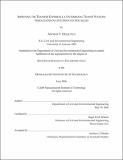Improving the transfer experience at intermodal transit stations through innovative dispatch strategies
Author(s)
Desautels, Andrew T. (Andrew Thomas)
DownloadFull printable version (3.786Mb)
Other Contributors
Massachusetts Institute of Technology. Dept. of Civil and Environmental Engineering.
Advisor
Nigel H.M. Wilson.
Terms of use
Metadata
Show full item recordAbstract
This research introduces the concept of a bus hold light system that is based on headways of arriving trains in an effort to improve rail-to-bus transfer connectivity through a simple-to-implement, low-cost dispatching strategy. An analytical model and a simulation model are developed to analyze the impacts of the proposed headway-based hold light system on total passenger wait time and other relevant measures of transfer performance. The application of the two models to the cases of Alewife and Wellington Stations in the Massachusetts Bay Transportation Authority (MBTA) system and to 79 Street Station in the Chicago Transit Authority (CTA) system shows that the headway-based hold light system can produce substantial passenger wait time savings if implemented in an appropriate setting. Throughout these analyses, the sensitivity of the headway-based hold light system to various factors is analyzed, and the results obtained with the headway-based hold light system are compared with those obtained from the application of other bus dispatching strategies, most notably the strategy of holding each departing bus for passengers transferring from the next train arrival. (cont.) Based on the case study results and sensitivity analyses, a set of guidelines for the implementation of headway-based hold light systems is proposed. In .the comparison of the headway-based hold light system and the hold-all-buses strategy, it is shown that the headway-based hold light system is superior when a large number of downstream boardings occur, due to its tendency to avoid holding bus trips with very few transferring passengers but many downstream passengers.
Description
Thesis (S.M.)--Massachusetts Institute of Technology, Dept. of Civil and Environmental Engineering, 2006. This electronic version was submitted by the student author. The certified thesis is available in the Institute Archives and Special Collections. Includes bibliographical references.
Date issued
2006Department
Massachusetts Institute of Technology. Department of Civil and Environmental EngineeringPublisher
Massachusetts Institute of Technology
Keywords
Civil and Environmental Engineering.